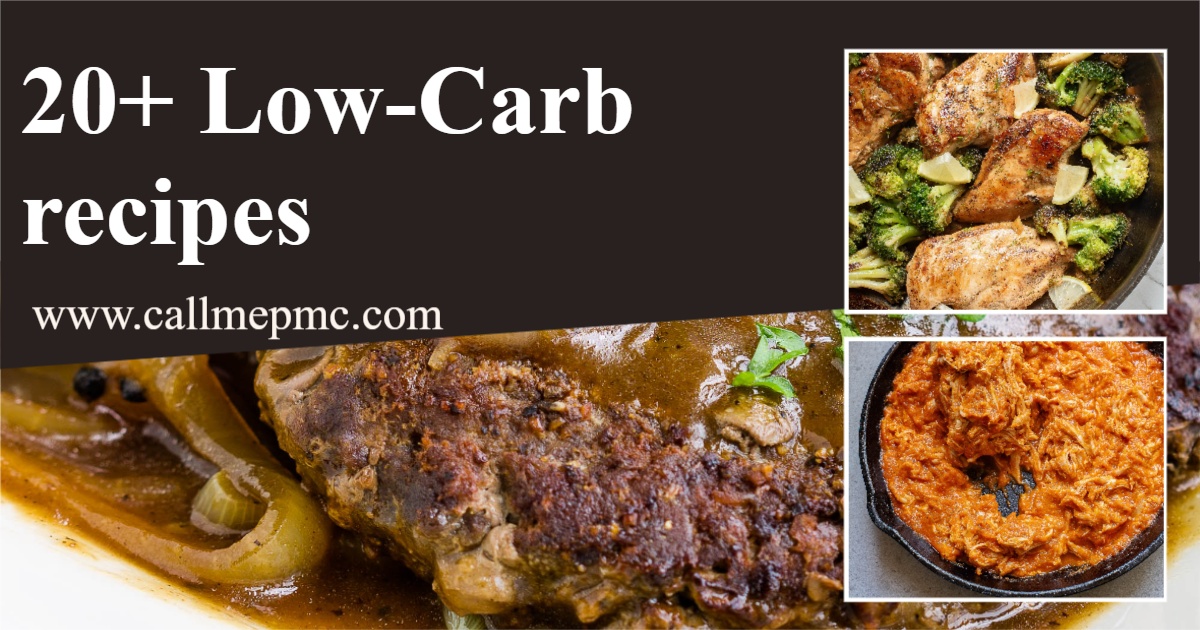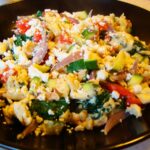Embark on a culinary journey with 30 delectable low-carb recipes designed to tantalize your taste buds at any time of day. From vibrant breakfast options to satisfying dinners and delightful desserts, this collection caters to every occasion, ensuring you never compromise on flavor while sticking to your dietary goals. Discover innovative techniques, ingredient substitutions, and meal-planning strategies that make low-carb eating both achievable and enjoyable.
This comprehensive guide not only provides a diverse range of recipes but also equips you with the knowledge to adapt them to your preferences and dietary needs. Learn how to source high-quality ingredients, master various cooking methods, and create a weekly meal plan that’s both delicious and efficient. Prepare to transform your approach to low-carb cooking and unlock a world of culinary possibilities.
Recipe Variations and Adaptations
Adapting recipes to suit different dietary needs and preferences, or to take advantage of seasonal ingredients, is a key skill for any home cook. This section explores variations and adaptations for a single recipe, demonstrating how simple changes can create entirely new culinary experiences while staying within low-carb guidelines. We’ll focus on enhancing flavor and texture while maintaining the integrity of the original recipe’s core concept.
Three Variations of Creamy Tuscan Chicken
The original Creamy Tuscan Chicken recipe features chicken breasts simmered in a rich, creamy sauce with sun-dried tomatoes, spinach, and Parmesan cheese. This recipe is naturally low-carb, but we will explore three variations to broaden its appeal: vegetarian, vegan, and gluten-free.
Vegetarian Variation: This version replaces the chicken with hearty portobello mushrooms, providing a meaty texture and umami flavor. Large portobello caps are marinated in a mixture of olive oil, garlic, and herbs before being pan-fried until tender. These are then added to the creamy sauce alongside the spinach and sun-dried tomatoes. The Parmesan cheese remains, offering a salty, sharp counterpoint to the earthy mushrooms.
Vegan Variation: To make this recipe vegan, the chicken is replaced with firm tofu, which is pressed to remove excess water and then pan-fried or baked until lightly browned. Parmesan cheese is omitted, and nutritional yeast is used to add a cheesy, savory flavor. The cream is replaced with full-fat coconut milk, which provides richness and creaminess without dairy. This version maintains the creamy texture and depth of flavor while adhering to vegan principles.
Gluten-Free Variation: The original recipe is already naturally gluten-free, assuming gluten-free Parmesan cheese is used. However, some commercially available sun-dried tomatoes may contain added gluten. To ensure the recipe remains gluten-free, it’s crucial to check the ingredient labels of all sun-dried tomatoes used. If gluten-containing sun-dried tomatoes are found, opt for those specifically labeled as gluten-free.
Adapting to Seasonal Ingredients
The Creamy Tuscan Chicken recipe can be easily adapted to utilize seasonal produce. For example, during summer months, fresh cherry tomatoes can be incorporated into the sauce, adding a burst of sweetness and juicy texture. Their vibrant red color also enhances the dish’s visual appeal. The fresh tomatoes’ slightly acidic quality would provide a welcome contrast to the richness of the sauce. In autumn, butternut squash can be roasted and pureed, then added to the sauce for a creamy, subtly sweet variation. The earthy sweetness of the butternut squash would complement the savory flavors of the other ingredients. Winter months offer the opportunity to use kale or other hearty greens in place of spinach, adding a slightly bitter counterpoint to the creamy sauce.
Taste and Texture Comparisons
The original Creamy Tuscan Chicken offers a rich, savory flavor profile with a tender chicken texture and a creamy, slightly tangy sauce. The vegetarian variation maintains the creamy texture but introduces an earthy, umami note from the mushrooms. The vegan variation retains the creaminess but has a slightly milder flavor profile due to the absence of Parmesan cheese, although the nutritional yeast provides a savory depth. The gluten-free variation is essentially identical in taste and texture to the original recipe, provided that gluten-free ingredients are used. The seasonal adaptations introduce variations in sweetness and acidity depending on the chosen produce, adding complexity and interest to the original recipe’s flavor profile. Each variation offers a unique culinary experience while remaining true to the core concept of a creamy, flavorful chicken (or substitute) dish.
Meal Planning and Preparation Strategies

Efficient meal planning and preparation are crucial for successfully adhering to a low-carb lifestyle. Strategic planning minimizes time spent in the kitchen, reduces food waste, and ensures you consistently enjoy delicious and nutritious meals. This section provides practical strategies and a sample meal plan to streamline your low-carb journey.
A Sample Weekly Low-Carb Meal Plan
A well-structured weekly meal plan simplifies the process of following a low-carb diet. This plan incorporates five recipes from the book, emphasizing efficient cooking techniques and minimizing leftovers. Note that portion sizes should be adjusted based on individual caloric needs.
- Monday: Creamy Tuscan Chicken (Recipe 7) – Prepare a large batch; enjoy leftovers for lunch on Tuesday.
- Tuesday: Leftover Creamy Tuscan Chicken with a side of steamed broccoli.
- Wednesday: Zucchini Noodles with Shrimp Scampi (Recipe 12) – Quick and easy weeknight meal.
- Thursday: Slow Cooker Beef Stew (Recipe 18) – Prepare in the slow cooker for minimal effort.
- Friday: Cauliflower Rice Stir-fry with Beef and Peppers (Recipe 25) – Use leftover beef from the stew.
- Saturday: Baked Salmon with Asparagus (Recipe 3) – A healthy and elegant weekend meal.
- Sunday: Leftovers or a simple salad with grilled chicken or fish.
Efficient Meal Prepping and Storage Strategies
Effective meal preparation significantly reduces cooking time during the week and minimizes food waste. These strategies ensure your low-carb meals are readily available and taste great.
- Batch Cooking: Prepare large quantities of proteins (chicken, beef, fish) and vegetables on the weekend. Portion them into individual containers for easy grab-and-go meals throughout the week. Imagine a vibrant scene: a large roasting pan filled with perfectly browned chicken breasts, surrounded by colorful bell peppers and broccoli florets, all ready to be portioned and stored.
- Strategic Vegetable Chopping: Chop vegetables like onions, peppers, and celery in advance. Store them in airtight containers in the refrigerator for easy addition to stir-fries, soups, and stews. Picture a neatly organized crisper drawer, brimming with prepped vegetables, ready to be incorporated into various recipes.
- Utilize Freezer Space: Freeze leftover cooked proteins, sauces, and vegetable purees in individual portions. This extends the shelf life of your meals and provides quick meal options on busy weeknights. Envision a well-organized freezer, neatly stacked with labeled containers of various low-carb meal components, each ready to be defrosted and transformed into a satisfying meal.
- Proper Storage Techniques: Use airtight containers to maintain the freshness and quality of your meals. Label and date all containers to ensure proper rotation of food. Imagine a refrigerator showcasing a rainbow of vibrant colors in perfectly organized containers, each labeled with the contents and date for efficient meal selection.
Adapting Recipes to Different Cooking Equipment
Many low-carb recipes can be easily adapted to various cooking appliances, offering flexibility and convenience. This section explores how to modify recipes for slow cookers and Instant Pots.
Many recipes, such as the Slow Cooker Beef Stew (Recipe 18), are naturally suited for slow cookers. The long, low cooking time allows the flavors to meld beautifully, resulting in a tender and flavorful dish. For recipes that aren’t explicitly designed for slow cookers, you can often adapt them by adjusting cooking times and liquid amounts. For instance, a chicken stew recipe intended for stovetop cooking could be easily adapted for a slow cooker by simply increasing the cooking time and adding a bit more liquid to prevent drying out.
Instant Pots provide a fast and efficient way to prepare low-carb meals. Recipes like the Creamy Tuscan Chicken (Recipe 7) can be adapted for the Instant Pot by using the sauté function to brown the chicken before pressure cooking. Adjusting cooking times is crucial; refer to your Instant Pot’s manual for specific guidelines. Imagine the convenience of having a perfectly cooked, flavorful chicken dish ready in a fraction of the stovetop cooking time, thanks to the efficiency of the Instant Pot.
With 30 low-carb recipes at your fingertips, culinary creativity knows no bounds. This collection empowers you to effortlessly navigate any occasion, crafting delicious and satisfying meals that align perfectly with your health goals. The detailed instructions, ingredient substitutions, and meal-planning tips provide a comprehensive framework for success, transforming your low-carb journey into a delightful and rewarding experience. Embrace the flexibility, savor the flavors, and embark on a culinary adventure that’s both delicious and healthy.
Top FAQs
Can I use substitutes for all ingredients?
While many ingredients have suitable substitutes, some substitutions may alter the taste and texture of the final dish. The guide provides detailed information on common substitutions and their impact.
How long do these meals last in the refrigerator?
Most recipes will last 3-4 days in the refrigerator when stored properly in airtight containers. Refer to individual recipe instructions for specific storage recommendations.
Are these recipes suitable for vegetarians/vegans?
Some recipes can be easily adapted for vegetarian or vegan diets. The guide includes variations for certain recipes to cater to different dietary preferences.
What equipment do I need to make these recipes?
The recipes are designed to be adaptable to various cooking equipment, including stovetops, ovens, slow cookers, and Instant Pots. Specific equipment requirements are mentioned in each recipe.


